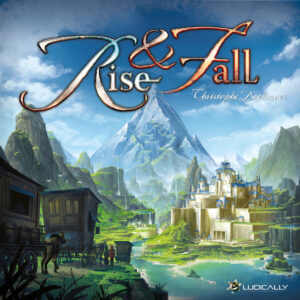Note: This preview uses pre-release components and rules. What you see here may be different from the final, published game. This post was a paid preview, you can find out more information here.
If you have read my previous reviews, you know that I love civilization-themed games. You also would know that, outside of some exceptions (Clash of Cultures), I do not like games with direct conflict with my opponents.
When I heard that Christopher Boelinger, designer of Archipelago, Earth Reborn, and Dungeon Twister, was designing a luckless Civilization game with limited direct conflict, I KNEW I wanted to play the game.
As luck would have it, this preview copy rolled into the shop and I was able to preview it!
Rise and Fall supports two to four players and games last about 30 minutes per player.
Gameplay Overview:
There are two distinct parts to a game of Rise and Fall.
Part 1 – Creating the world
Players alternate laying out Sea, Plains, Forest, Mountain, and Glacier Tiles, building the world they are about to settle.
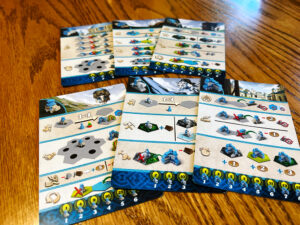
Part 2 – Conquering the world
Players take turns, with each turn divided into six phases:
- Play a Civilization card – All players simultaneous pick a Civilization card and play it—this allows the player to do something based on the game piece depicted on the card (note that EVERY player has the same set of six Civilization cards).
- Take Actions – In player order, the player will take one of the actions on the Civilization card that they played.
- Decline – (This only happens if a trophy was taken at the end of B.) – Players simultaneously take one of their Civilization cards and place it in the Decline Zone – if no trophy was earned, this phase is skipped.
- Purchase a Civilization Card from the Decline Zone – Players can simultaneously purchase one of their cards from the Decline Zone, the price of which goes up for every trophy that has been claimed.
- Recycle Cards and pass First Player Token – If one or more players have no cards in their hand, all players with no cards take their discard pile into their hand. If this happens, the First Player marker is passed to the next player.
- End of Turn – Unless the number of trophies claimed equals the number that triggers end game, Phase A is started again.
Once the number of trophies claimed equals the number of trophies that will trigger the end game (between four and six, decided on by the players at the start of the game), the game ends and Victory Points are tallied. The player with the most points wins!
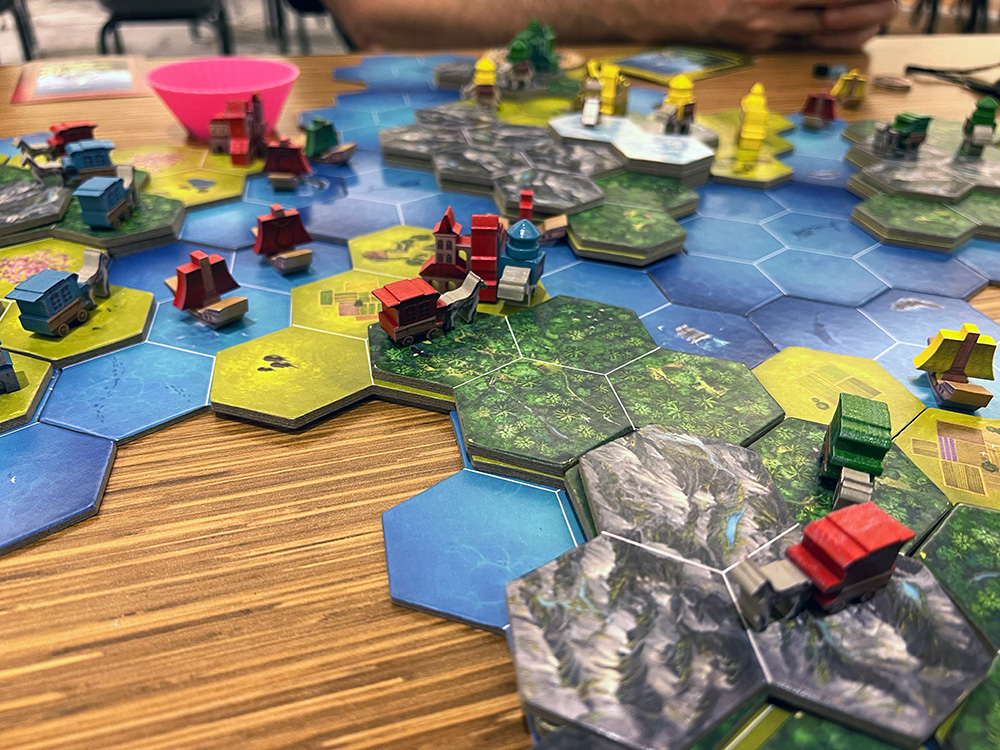
Gameplay Impressions:
Rise and Fall is interesting because building the map you are conquering is part of the game. Unlike most civ games where you flip/place a tile when you reach an unexplored area, players build the map together at the start of the game. The entire map is known by everyone. As stated above, players take turns placing tiles, starting with the lowest altitude pieces, and ending with the highest. It actually creates interesting choices between building the world how you would like the map to be versus trying to foil the land building plans of your opponent. When completed, you will have a surprisingly pleasing topographical map that is unique every time you play. The topography also has a gameplay impact because Nomads, one of the most common game pieces, cannot traverse cliffs (places where the difference in elevation is more than one level).
You may be asking yourself “What is a Nomad?” It is one of the six game piece types included in Rise and Fall: Nomads, Cities, Ships, Temples, Mountaineers, and Merchants. They all do different things and have their own restrictions.
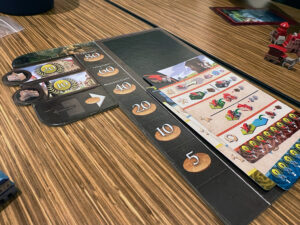
Only the cards for game pieces that are in play are available to you, with all other cards kept in the reserve. Once a card is played it goes to your discard pile. Once you have no cards in your hand, you take your discard pile back in your hand and the first player token is passed to the left. If you ever remove the last game piece of a type, like transforming your last Ship into a Nomad, that card, the Ship in my example, is removed from your hand or discard pile and placed in your reserve. Similarly, if you place the first of a piece on a board, the card is taken from the reserve to your hand.
Why did I use two paragraphs explaining all of that? While it may not seem like much, the interdependent relationship between these cards creates the main focus of the gameplay: which card should I play? When you play a card, each game piece that matches the card played can do one of the actions on that card. If you have four nomads on the map, should you produce four resources or should you only produce two resources and move the other two Nomads so they can construct cities in beneficial locations the next time you play the Nomad card?
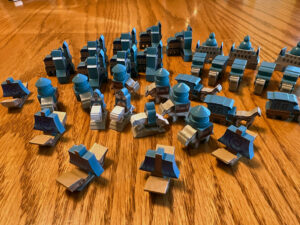
The other interesting aspect is the timing of cards. If you have fewer cards available, you will churn through your cards quicker, allowing you to focus on three pieces instead of all six. But focusing on three cards could be detrimental as you will be limited in your options for exploring (for example, if you do not have any ships moving across continents is difficult). So, the pace of play is important and needs to be considered when trying to outsmart your opponents.
Finally, the game has a unique scoring system. Trophies are awarded to the player who gets out all of their game pieces of the same type. There are six trophies available, one for each type of game piece. Every time a trophy is awarded, players must move one of their cards into Decline. Any game pieces that match the card stay on the board, but they will not be able to be used until the card is purchased from the Decline pile. As more trophies are awarded, the cost to purchase cards back from the Decline pile increases. The game ends when the number of trophies agreed upon to end the game is reached.
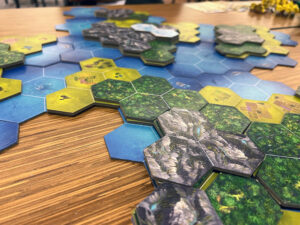
That is NOT the end of scoring. Yes, you get points for each trophy you win. You also get points on money in hand, the number of units on the board that are NOT in reserve or in Decline, and, most importantly, territories. Each group of similar, adjacent territories is a region. Whoever has the most pieces in a region scores points equal to the number of spaces in the region times the value of the region (plains are one, sea is two, forests are three and mountains/glaciers are four). If there is a tie, NO points are scored! As mentioned earlier about pace of game, this is where having less cards may hurt you as you may not be able to spread out enough to capture enough points to win the game. This is the balancing act that must be managed throughout the game.
Final Thoughts:
If you have ever wanted to play a luck-free civilization game without complicated combat, this game may be for you. It is easy to set up and teach, plays quickly and no game ever plays the same.
If this preview piqued your interest in Rise and Fall (or even if it did not), it’s launching soon on Kickstarter. You can follow the page here.







